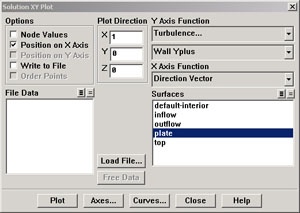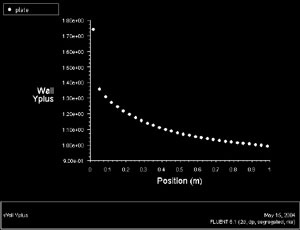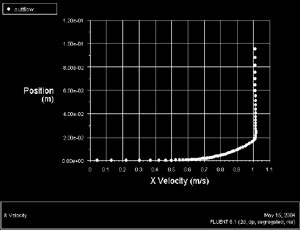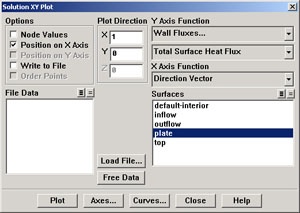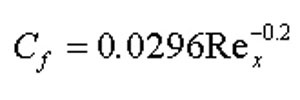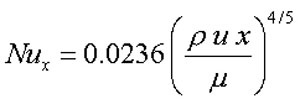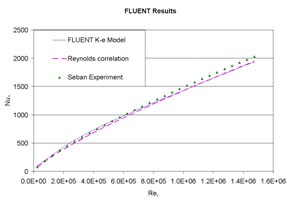...
Make sure that Position on X Axis is set under Options, that 1 is the value next to X, and 0 is the value next to Y under Plot Direction. Recall that this tells FLUENT to plot the x-coordinate value on the abscissa of the graph. Select Turbulence... under Y Axis Function and select Wall Yplus from the drop down list under that. Since we want the y+ value for cells adjacent to the wall of the pipe, choose plate under Surfaces.
Click Plot.
(Click picture for larger image)
| newwindow | ||||
|---|---|---|---|---|
| ||||
https://confluence.cornell.edu/download/attachments/90745540/06_yplus2.jpg?version=1 |
As we can see, the wall y+ value is between 1.0 and 1.4 (ignoring the anamolous at the inflow). Because these values are less than 5, the near-wall mesh resolution is in the laminar sublayer, which is the most accurate region to which we can resolve the boundary layer.
...
Uncheck Write to File. Click Plot.
(Click picture for larger image)
| newwindow | ||||
|---|---|---|---|---|
| ||||
https://confluence.cornell.edu/download/attachments/90745540/06_outflow2.jpg?version=1 |
We notice here that the x velocity reaches 1 m/s at approximately y = 0.02 m. This shows the relative thinness of the boundary layer compared to the length scale of the plate. We also notice that the velocity profile is slightly greater than 1 m/s above the boundary layer. We know this would not happen in real flow, rather it is a result of the boundary condition we have chosen for our model. We chose the Symmetry boundary condition at the top of our flow field, which is essentially a wall without the no-slip condition. Thus, no flow is permitted to escape through this boundary.
...
Recall that the Nusselt Number is a non-dimensional heat transfer coefficient that relates convective and conductive heat transfer.
In order to obtain the Nusselt Number from FLUENT, we will begin by plotting Total Surface Heat Flux.
...
In the Options box, change back to Position on X Axis. In the Plot Direction box, enter the default values of 1 in the X box and 0 in the Y box. Under Y-Axis Function choose Wall Fluxes. In the box below, chose Total Surface Heat Flux. Select Plate under Surfaces. Before plotting, be sure to turn on Auto Range for the Y axis under Axes....
Click Plot.
(click picture for larger image)
| newwindow | ||||
|---|---|---|---|---|
| ||||
https://confluence.cornell.edu/download/attachments/90745540/06_heatflux4.jpg?version=1 |
Now Select Write to File. Save the data for this plot as heatflux.xy. Click Write....
...
Reynolds Number can be defined at each x location by
Now plot Re vs. Nu in Excel. Your plot should look like this:
(click picture for larger image)
| newwindow | ||||
|---|---|---|---|---|
| ||||
https://confluence.cornell.edu/download/attachments/90745540/06_fluent_results2.jpg?version=1 |
Compare Results with Correlation & Experiment
| Wiki Markup |
|---|
Validate your results form FLUENT by comparing to a correlation and experimental results. The correlation we will use is derived by Reynolds \[1\]: |
All properties in this correlation are evaluated at the free-stream static temperature of 300K.This correlation assumes the following:
...
6. Friction factor calculated from the following relation (implicit in Nu equation above, does not need to be calculated in your analysis):
Add the Reynolds correlation for Nusselt Number to your Excel spreadsheet.
| Wiki Markup |
|---|
Seban & Doughty \[2\] performed a heated flat plate experiment for which they derived the following expression for Nusselt Number: |
The Seban & Doughty experiment was performed with air as the fluid (Pr = 0.7) and at various Reynolds Numbers in the range 1e5 < Re < 4e6. Add the this experimental relation for Nusselt Number to your Excel spreadsheet.
Now plot and compare Re vs. Nu from FLUENT, the Reynolds Correlation, and Seban's experiment.
(click picture for larger image)
| newwindow | ||||
|---|---|---|---|---|
| ||||
https://confluence.cornell.edu/download/attachments/90745540/06_fluentr11.jpg?version=1 |
As we can see, there is very little variation between these 3 results. The largest % error between the FLUENT results and the Reynolds correlation is only 7.5%. In turbulent flow as we have here, similar results between FLUENT and correlation are more difficult to come by than in laminar flow because a turbulent model must be used in FLUENT, which does not solve the Navier-Stokes Equations exactly. Experimental error (in experiments from which correlations are derived) also accounts for some of this 7.5% error. Each of the turbulence models that FLUENT offers produces results similar to these, although the k-epsilon model is the most appropriate model to use in this case.
...
 Sign-up for free online course on ANSYS simulations!
Sign-up for free online course on ANSYS simulations!